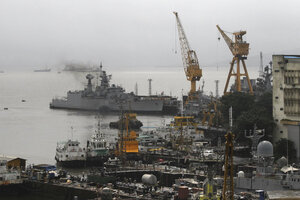Explosion at Mumbai port sinks Indian submarine
A series of explosions aboard a Russian-built Indian naval submarine partially sank the vessel. This is the 2nd explosion on a Russian-made sub in India in 3 years.

Ships ride at anchors at a naval dockyard where a submarine caught fire and sank after an explosion early Wednesday in Mumbai, India. India’s Defense Minister A.K. Antony confirmed loss of lives in the explosion, but gave no details. Eighteen sailors were trapped aboard the submarine, the Indian navy said.
Rafiq Maqbool/AP
Only days after the Indian Navy celebrated one of its proudest achievements, it is now mourning one of its greatest losses.
Last night, an explosion took place aboard an Indian submarine docked at port in Mumbai, killing 18 crew members. The blast occurred shortly after the launch of India’s first ever domestically-built aircraft carrier, widely hailed as one of the Navy’s greatest accomplishments. However, the submarine’s loss has had a sobering effect, drawing attention to the country’s aging fleet in dire need of modernization.
"It's a great loss to us.... it's the greatest tragedy of recent times," said Defense Minister A.K. Antony, reports the BBC.
Firefighters rushed to the scene of the explosion to put out the fire, which took two hours to extinguish. According to the Associated Press, all 18 sailors trapped aboard the INS Sindhurakshak have been confirmed dead.
The explosion, which occurred early Wednesday morning, took place in the submarine’s torpedo compartment, reports Reuters.
"Lot of things are in very close proximity, there is fuel, there is hydrogen, there is oxygen, there are weapons with high explosives on board," said retired Indian navy chief Arun Prakash.
"So a slightest mistake or slightest accident can trigger off a huge accident. The question of sabotage – I mean, all possibilities have to be considered – but sabotage is probably the last possibility."
The INS Sindhurakshak, built by and purchased from Russia in 1997, has had a turbulent history, according to the BBC. In February 2010, a fire broke out on board, killing one crew member. India subsequently sent it to Russia for a refit, which was only completed in June 2012, and which cost $80 million.
Nor is the submarine the Navy’s only vessel to experience accidents, writes the Hindu. In 2008, another submarine barreled into a merchant vessel during naval exercises. And in 2011, a warship collided with yet another merchant boat, causing a fire to break out.
The tragedy aboard the INS Sindhurakshak has damped the convivial mood among India’s Navy after the launch of its first domestically built aircraft carrier. As The Christian Science Monitor reports, the launch of the INS Vikrant was a watershed moment for India, a demonstration of its success and influence both regionally and globally.
By enabling countries to deploy air power far from their own shores, carriers have become the unit by which modern navies are measured. Only a handful of countries have them and can build them, with the majority of such vessels in the hands of the US Navy.
So it's no small thing that India today launched its first domestically built carrier. With the first-phase launch of what will eventually be named the INS Vikrant, India joins an elite club of countries that have built their own carriers: Only the United States, Russia, France, and Britain have done the same.
But the destruction of INS Sindhurkshak has gravely handicapped the Navy’s fleet, which is already old and needs to be upgraded to modern standards, according to Reuters. Efforts to refurbish the Indian fleet have been held back by corruption scandals.
In an interview with The Wall Street Journal, retired Rear Admiral Pradeep Kaushiva explained the impact the submarine explosion has on the Navy:
The fleet is far more aged then we would have liked. The number of submarines that are operational, because of those that are undergoing repairs, is less than was planned. There is a rolling plan for re-stocking the fleet and this hasn’t been met because production of new vessels has been deferred. And because the fleet is already small if one or two are out of action, that makes a big difference. It’s like having a fleet of 10 cars and six are very old, so your operational capacity is reduced.

